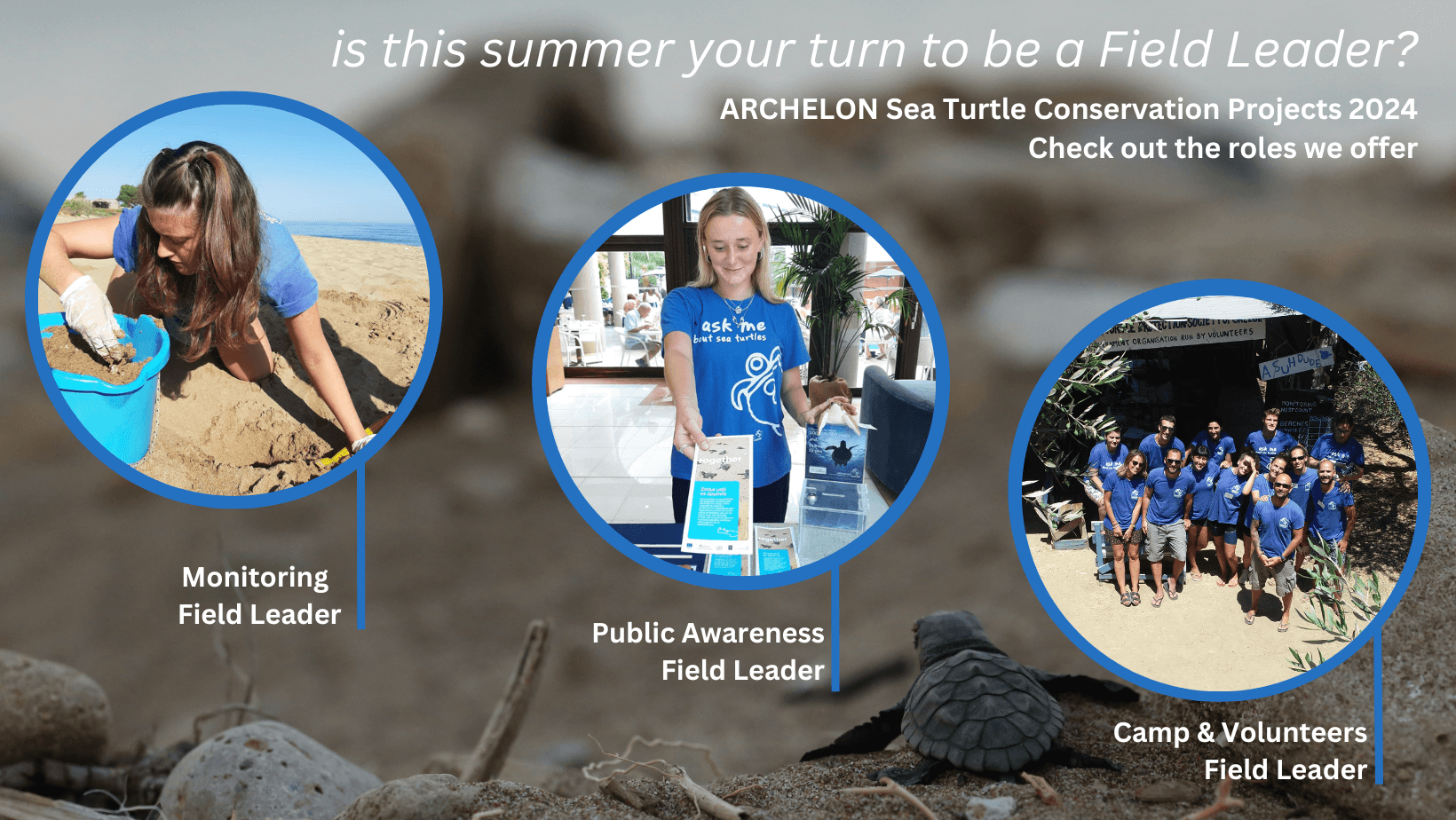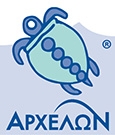Summer 2024: Come back to sea turtle conservation as a leader!
Field Leaders are a special category of volunteers in ARCHELON projects: they are experienced and skilled individuals that are selected to lead the different activities of each sea turtle conservation project.
ARCHELON’s sea turtle field projects in Greece are organised every summer with the valuable contribution of volunteers. They involve monitoring and protecting the reproduction of loggerhead sea turtles and raising public awareness about their nesting beaches. Participation to all 8 projects is open and inclusive and volunteers from all over the world can join them. Field Leaders undertake tasks and responsibilities related to project activities and ensure the high quality of work done by the other volunteers.
Why should I join or return as a Leader?
You will be part of an international team with the mission to record and protect loggerhead turtle nests and hatchlings. You will be responsible for the implementation of a specific objective in the project working alongside other volunteers. The Field Leader positions provide a higher level of experience and responsibility in conservation/ environment projects, and help you achieve improved communication and leadership skills. You will receive the necessary guidance and training, which are based on the continuously evolving practices of projects running for 40+ years.
Field Leaders do not receive a salary but they are provided with non-fee training, camping accommodation, basic food expenses, as well as insurance against accidents. Candidates with previous experience as field leaders in ARCHELON’s or other relevant projects will be eligible for additional benefits. Returning to the projects as a Field Leader is a great opportunity to lead specific activities as well as train and help others.
What are the specific tasks of Field Leaders?
Field Leaders are responsible for leading the teams and ensuring the proper on-site implementation of
- sea turtle monitoring actions (Monitoring Field Leaders)
- public awareness and fund raising actions (Public Awareness Field Leaders) and
- the good state of ARCHELON Research Stations (Camp and Volunteer Leaders)
Together they formulate the weekly schedule of shifts, train volunteers and boost their motivation. They manage occurring issues in cooperation with the Project Managers.
Each project recruits a different number of Field Leaders and assigns responsibilities depending on the expected work load in different activities, which are specific to the area.

You can find out more details on what a Monitoring Field Leader , a Public Awareness Field Leader and a Camp and Volunteers Field Leader do in the projects and whether these match your experience and interest.
How can I become a Field Leader?
To be eligible for a Field Leader post, you need to be over 20 years old, with a car driving license (EU or international), be fluent in English and ready to spend from 3 – 6 months on the site. Having previously participated in ARCHELON’s projects is a serious advantage.
If interested, you need to send an email to jobs@archelon.gr with:
- The Application form
- A Short Curriculum Vitae (400-900 words)
Applications and short CVs for 2024 are now open! Early applications have a higher chance to be successful as vacancies are limited.
Initial deadline for applications is 11 February 2024. However, applications will continue to be reviewed past this deadline until all positions are filled. Short interviews will begin on February 1st and will continue until all field leading teams are complete.
More information on Field leaders here Find out who were the Field Leaders in 2023 here
Notes of a volunteer (Part 1): Jessica Van Damme was at the Rescue Centre
The establishment of the “Amvrakikos Alliance”
RECENT NEWS
- OUR NEWS26/11/2025
A Second Chance: Two Loggerhead Sea Turtles Return to the Sea Thanks to Dedicated Rescues
This summer, two adult loggerhead sea turtles, ‘Aktaia’ and ‘Herbert’, arrived at ARCHELON’s Sea Turtle Rescue Centre needing urgent help after sustaining severe head injuries.
- OUR NEWS11/11/2025
Volunteering Projects 2026: Sea Turtles Need You, the Planet Needs Us!
ARCHELON welcomes volunteers from all over the world and of all ages (over 18) and no prior experience is required! If you speak English, are at least 18 years old, and are in good physical condition, you can do this!
- OUR NEWS10/11/2025
Outstanding Recognition for ARCHELON at the Effective Dialogue Conference 2025
On Thursday, November 6, 2025, ARCHELON received an honorary distinction for its substantial contribution to effective dialogue on sustainability, social responsibility, and the environment
- OUR NEWS06/11/2025
6th Year of Online Tours: The sea turtles are traveling across Greece once again!
Students from every corner of the country, as well as from international schools, have the opportunity to learn up close about the lives of the turtles cared for at the Sea Turtle Rescue Centre in Glyfada, Attica, and to discover how rescue efforts impact the marine world.
- OUR NEWS31/10/2025
The lecture turned into reality: A real turtle rescue for the students from Kallithea!
The students spotted a sea turtle floating in the water right after their educational tour of the ARCHELON Rescue Centre and immediately notified the rescuers.
- OUR NEWS24/10/2025
Filming of the LIFE MareNatura documentary is completed
From seabird monitoring and genetic sampling, to unique underwater footage of marine mammals, the testimonies of scientists bring to life the hidden stories of the sea.
- OUR NEWS23/10/2025
ARCHELON participates in the "Science Festival 2025 – The Voice of the Ocean"
The French Institute of Greece is organizing a celebration from 10 to 27 November 2025 dedicated to science and the ocean! World premiere of the LIFE MareNatura documentary on November 13th.
- OUR NEWS22/10/2025
Kyparissia Bay: ARCHELON Records 6,100 Nests and Calls on the State to Immediately Implement the National Action Plan for the Loggerhead
In 2025 approximately 6,100 nests were recorded, marking a 74% increase compared to the average of the previous 12 years!
- OUR NEWS10/10/2025
We bid farewell to a devoted environmentalist and friend, Yiannis Roussopoulos.
- OUR NEWS02/10/2025
Jane Goodall’s words still warm our hearts
Thank you, Dr. Goodall, for all that you have taught us and for the life example you have left behind.
- OUR NEWS29/09/2025
Turtles, Dolphins, and Birds: Local Communities and Scientists come together for the future of Amvrakikos Gulf
A one-day conference held on Wednesday, September 24, in Menidi, Amfilochia, united the voice of the local community with leading scientists and environmental organizations for Amvrakikos Gulf.
- OUR NEWS26/09/2025
Biologists from the 'LIFE ADAPTS' project send their message to the community
- OUR NEWS23/09/2025
Aquila Rithymna Beach Hotel becomes an Advocate for ARCHELON in Rethymno
The hotel's generous donation directly supports the costs of conservation activities during the 2025 and 2026 nesting seasons.
- OUR NEWS19/09/2025
A Season of Success for the Amvrakikos Project
The 2025 field season for ARCHELON's Amvrakikos project has officially come to a close!
- OUR NEWS12/09/2025
Τhe first green sea turtle nest has hatched in Naxos island!
The emergence of a nest on Naxos is a sign that the geographical range of this threatened species in the Mediterranean may be expanding.


